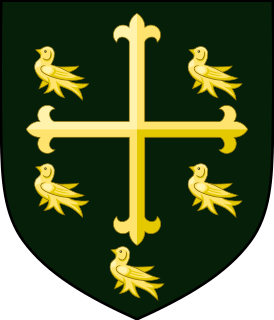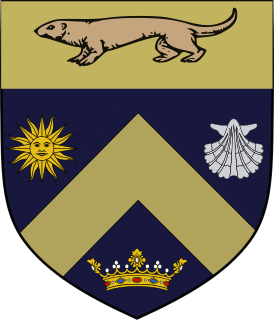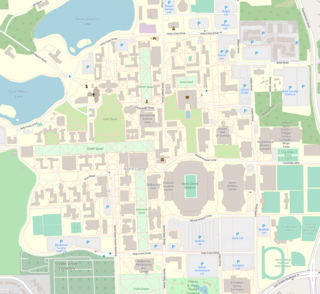
The University of Notre Dame du Lac is a private Catholic research university in Notre Dame, Indiana, outside the city of South Bend. It was founded in 1842 by Edward Sorin. The main campus covers 1,261 acres (510 ha) in a suburban setting; it contains a number of recognizable landmarks, such as the Golden Dome, the Word of Life mural, Notre Dame Stadium, and the Basilica.

The University of Notre Dame Australia is a national Roman Catholic private university with campuses in Fremantle and Broome in Western Australia and Sydney in New South Wales. The university also has eight clinical schools as part of its school of medicine located across Sydney and Melbourne and also in regional New South Wales and Victoria.

John Francis O'Hara was an American member of the Congregation of Holy Cross and prelate of the Catholic Church. He served as President of the University of Notre Dame (1934–39) and as the Archbishop of Philadelphia from 1951 until his death, and was elevated to the cardinalate in 1958.

Notre Dame is a census-designated place north of the city of South Bend in St. Joseph County, in the U.S. state of Indiana. It includes the campuses of three colleges: the University of Notre Dame, Saint Mary's College, and Holy Cross College. Notre Dame is split between Clay and Portage Townships. As of the 2010 census, its population was 5,973.

Rev. Edward Frederick Sorin, C.S.C. was a priest of the Congregation of Holy Cross and the founder of the University of Notre Dame in Indiana and of St. Edward's University in Austin, Texas.

Saint Mary's College is a Catholic women's liberal arts college in Notre Dame, Indiana. Founded in 1844 by the Sisters of the Holy Cross, the name of the school refers to the Blessed Virgin Mary.

The Rev. John Augustine Zahm, CSC was a Holy Cross priest, author, scientist, and South American explorer. He was born at New Lexington, Ohio, and died in Munich, Germany.

The Basilica of the Sacred Heart in Notre Dame, Indiana, USA, is a Roman Catholic church on the campus of the University of Notre Dame, also serving as the mother church of the Congregation of Holy Cross (C.S.C.) in the United States. The neo-gothic church has 44 large stained glass windows and murals completed over a 17-year period by the Vatican painter Luigi Gregori. The basilica bell tower is 230 feet (70 m) high, making it the tallest University chapel in America. It is a contributing building in Notre Dame's historic district listed on the National Register of Historic Places. The Basilica is a major tourist attraction in Northern Indiana, and is visited annually by more than 50,000 tourists.

The Rev. William Corby, CSC was an American priest of the Congregation of Holy Cross, and a Union Army chaplain in the American Civil War attached to the Irish Brigade. He served twice as president of the University of Notre Dame.
The Sisters of Holy Cross, headquartered in Montreal, Quebec, Canada is an international Catholic congregation of religious sisters which traces its origins to the foundation of the Congregation of Holy Cross in 1837 in Le Mans, France by the Blessed Father Basil Anthony-Marie Moreau, CSC. Two other congregations of sisters also have the same origins: the Marianites of Holy Cross and the Sisters of the Holy Cross.

St. Edward's Hall is one of the thirty undergraduate residence halls on the campus of the University of Notre Dame and one of fifteen male dormitories. Saint Edward's Hall is located directly east of the Main Administration Building and is directly west of Zahm Hall. Saint Edward's Hall houses 162 undergraduate students. It is, together with other historical structures of the university, on the National Register of Historic Places. The coat of arms is the Cross of Saint Edward the Confessor on a green background.

Sorin Hall, also known as Sorin College, is the oldest of the 30 Residence Halls on the campus of the University of Notre Dame and one of the 16 male dorms. Sorin is located directly north of Walsh Hall and is directly south of the Basilica of the Sacred Heart. Sorin houses 143 undergraduate students. Its distinctive turret rooms on the four corners as well as its pure nobility distinguish it from all other campus buildings. Sorin Hall is, along with other building on the Main Quad of Notre Dame, on the National Register of Historic Places. Sorin Hall was the first Notre Dame residential hall established as such, although St. Edward's Hall is housed in an older building.

Badin Hall is one of the 30 Residence Halls on the campus of the University of Notre Dame and one of the 14 female dorms. it is located on South Quad, between Howard Hall and the Coleman-Morse center. Badin Hall is, along with other buildings at Notre Dame, on the National Register of Historic Places. It was named after Fr. Stephen Badin, the first priest ordained in the US.
There are currently 31 undergraduate residence halls at the University of Notre Dame. Several of the halls are historic buildings which are listed on the National Register of Historic Places. Each residence hall is single-sex, with 17 all-male residence halls and 14 all-female residence halls. Notre Dame residence halls feature a mixed residential college and house system, where residence halls are the center of the student life and some academic teaching; most students stay at the same hall for most of their undergraduate studies. Each hall has its own traditions, events, mascot, sports teams, shield, motto, and dorm pride. The university also hosts Old College, an undergraduate residence for students preparing for the priesthood.

University of Notre Dame's Main Administration Building houses various administrative offices, including the Office of the President. Atop of the building stands the Golden Dome, the most recognizable landmark of the university. Three buildings were built at the site; the first was built in 1843 and replaced with a larger one in 1865, which burned down in 1879, after which the third and current building was erected. The building hosts the administrative offices of the university, as well as classrooms, art collections, and exhibition spaces. The building is listed on the National Register of Historic Places.

Washington Hall at the University of Notre Dame in Notre Dame, Indiana is the seventh oldest university owned building on the historic campus. It is part of the University of Notre Dame: Main and North Quadrangles historic district, listed on the National Register of Historic Places, and was the original home of the university's music and performing arts programs.

The University of Notre Dame was founded on November 26, 1842 by Father Edward Sorin, CSC, who was also its first president, as an all-male institution on land donated by the Bishop of Vincennes. Today, many Holy Cross priests continue to work for the university, including as its president. Notre Dame rose to national prominence in the early 1900s for its Fighting Irish football team, especially under the guidance of the legendary coach Knute Rockne. Major improvements to the university occurred during the administration of Rev. Theodore Hesburgh between 1952 and 1987 as Hesburgh's administration greatly increased the university's resources, academic programs, and reputation and first enrolled women undergraduates in 1972.

Notre Dame University Bangladesh or NDUB is a private Catholic university in Bangladesh. Located in Motijheel, Dhaka, the university was founded by the Congregation of Holy Cross in 2013. After receiving approval from the Ministry of Education, the People’s Republic of Bangladesh, and University Grants Commission (UGC), Notre Dame University Bangladesh commenced its academic activities in the fall of 2014.

The Campus of the University of Notre Dame is located in Notre Dame, Indiana, USA, spans 1,250 acres, and comprises around 170 buildings. Notre Dame's campus is consistently ranked and admired as one of the most beautiful university campuses in the United States and around the world, particularly noted for the Golden Dome, the Basilica and its stained glass windows, the quads and the greenery, the Grotto, Touchdown Jesus, and its statues and museums. Notre Dame is a major tourist attraction in northern Indiana; in the 2015–2016 academic year, more than 1.8 million visitors, almost half of whom were from outside of St. Joseph County, visited the campus.

The Columbus murals are a series of twelve murals depicting Christopher Columbus, painted in the 1880s by Luigi Gregori and displayed in the Main Building at the University of Notre Dame. The murals have been a source of controversy in recent decades for their romanticized portrayal of Columbus and his relationship with Native Americans.


















